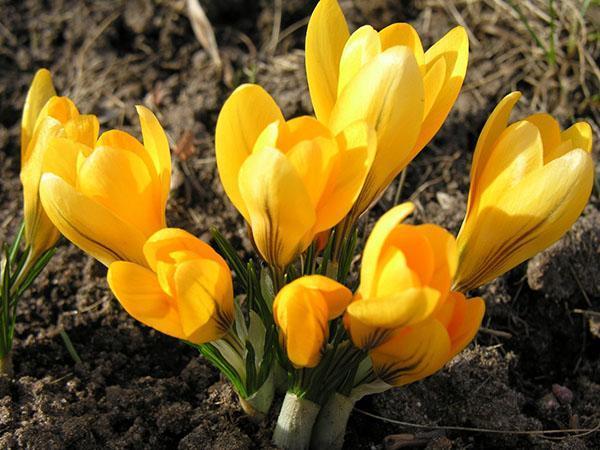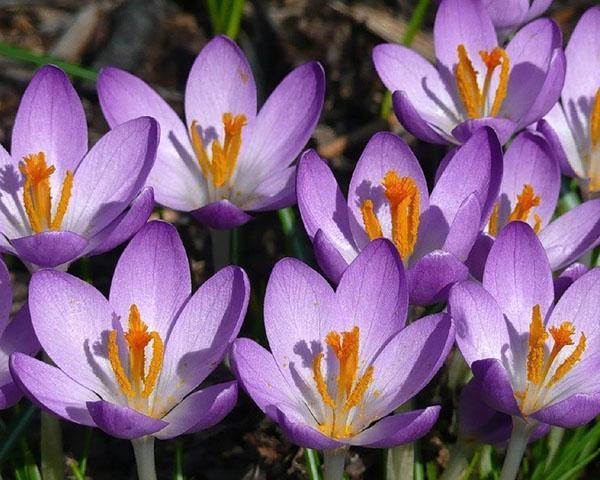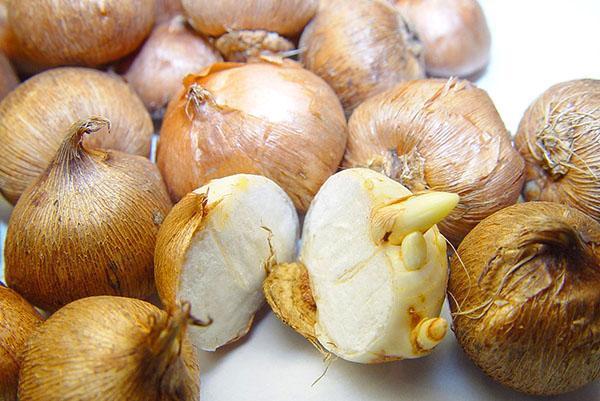Planting crocuses of different flowering dates in open ground
 Crocuses: planting and caring for them in the open field requires specific knowledge so that this fragile and delicate flower takes root in the soil and pleases the eyes of the owners with its variegated petals. Another name for the plant is saffron, and most gardeners believe that it blooms exclusively in the spring. However, breeders have long bred special varieties of crocuses that can bloom in autumn.
Crocuses: planting and caring for them in the open field requires specific knowledge so that this fragile and delicate flower takes root in the soil and pleases the eyes of the owners with its variegated petals. Another name for the plant is saffron, and most gardeners believe that it blooms exclusively in the spring. However, breeders have long bred special varieties of crocuses that can bloom in autumn.
The choice of planting material and landing site

 How to Pick Viable Saffron Bulbs:
How to Pick Viable Saffron Bulbs:
- Under proper storage conditions, the planting material will not have extra shoots and sprouted roots.
- Healthy bulbs are fairly heavy and firm. If, upon contact with a part of the plant, their lethargy and looseness is felt, then they are unlikely to be able to germinate.

- Dark spots on the surface of the crocus bulb indicate that they are rotted.
- If the planting material has any mechanical damage, it is also better to refuse it.
Even healthy parts of future flowers require pre-treatment before planting. It is necessary to peel off the old skin from the bulbs and disinfect them by sprinkling with ash or keeping them in a manganese solution.
Planting and caring for crocuses in the open field should take place in spacious flower beds (flowers can occupy the entire area in a short time). They should be located in an open area with plenty of sunlight. Therefore, it is not recommended to plant saffron under densely crowned trees.
 The soil for crocuses of all subspecies should not be excessively wet. The soil structure should be loose, nutritious, light and non-acidic. Do not be afraid if the soil in the garden does not meet these requirements, it can be made suitable for saffron using simple methods. Large river sand, gravel or crushed stone, which is used as a drainage layer, will help get rid of excessive moisture. The acidity of the soil neutralizes the mixture peat and lime, ash or rotted manure.
The soil for crocuses of all subspecies should not be excessively wet. The soil structure should be loose, nutritious, light and non-acidic. Do not be afraid if the soil in the garden does not meet these requirements, it can be made suitable for saffron using simple methods. Large river sand, gravel or crushed stone, which is used as a drainage layer, will help get rid of excessive moisture. The acidity of the soil neutralizes the mixture peat and lime, ash or rotted manure.
Crocus planting time in the garden
 When to plant crocuses outdoors? It all depends on the type of plant that the gardener has chosen, but they are all divided into flowers that bloom in spring or autumn.
When to plant crocuses outdoors? It all depends on the type of plant that the gardener has chosen, but they are all divided into flowers that bloom in spring or autumn.
Spring flowering plants include:
- spring crocus - bred as a decorative flower since the 16th century, grows up to 17 cm high, the buds are lilac or white;

- two-flowered crocus - the most variegated variety of saffron blooming in spring;

- golden crocus - the name speaks for itself: the petals of this saffron have yellow buds of different shades, the plant reaches up to 20 cm in height.

Since the flowering of these subspecies of ornamental flora occurs in the spring, crocuses are planted in open ground in the fall. They should be planted from late September to early October.
If the spring-flowering varieties are planted before the second half of September, then the saffron can bloom by the frost period and eventually die.And if you plant a flower later than the first half of October, then the soil for the bulbs will be too cold, they will not be able to take root in it and will simply freeze.
Autumn-flowering saffron subspecies include:
- beautiful crocus - a fairly large plant up to 30 cm high, the buds are white, blue and lilac in color;

- cute crocus - frost-resistant subspecies;

- Crocus Banat - has lilac buds and unusual silvery leaves.

Flowers bloom in the garden in autumn, and therefore crocuses are planted in the ground in spring (late May) or early summer (first half of July).
How to care for saffron?
 Saffron is not a flower that needs abundant watering. If autumn or spring (depending on what kind of flower is planted) were rich in precipitation, then they should be watered only when the soil becomes dry not only on the surface, but also in depth. Otherwise, the plants can simply rot.
Saffron is not a flower that needs abundant watering. If autumn or spring (depending on what kind of flower is planted) were rich in precipitation, then they should be watered only when the soil becomes dry not only on the surface, but also in depth. Otherwise, the plants can simply rot.
Crocus care outdoors is fairly easy. Periodically, you will need to weed the flower rows, getting rid of weeds. The soil (especially after rain) must be loosened so that the root system of the plants gains access to air.
 Like any decorative flowers, crocuses need feeding. However, it is not recommended to fertilize saffron with organic mixtures. Better to buy granular mineral feedingenriched with potassium and phosphorus. Nitrogen fertilizers should be applied with caution, in small doses, as they can provoke the growth of fungus on the plant bulbs.
Like any decorative flowers, crocuses need feeding. However, it is not recommended to fertilize saffron with organic mixtures. Better to buy granular mineral feedingenriched with potassium and phosphorus. Nitrogen fertilizers should be applied with caution, in small doses, as they can provoke the growth of fungus on the plant bulbs.
Top dressing should be applied in at least 2 stages: first, fertilize the soil before planting crocuses, and then during the period of their increased growth.
Below are photos of crocuses in the open field:


